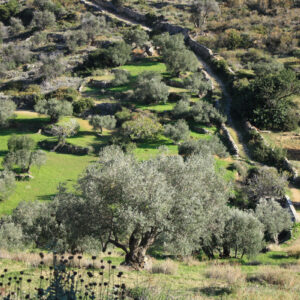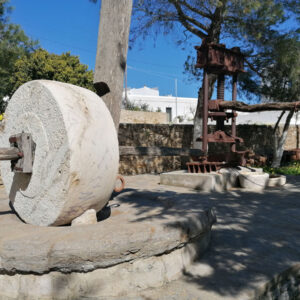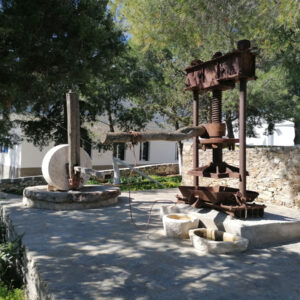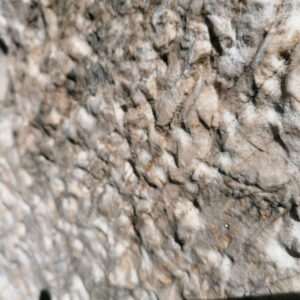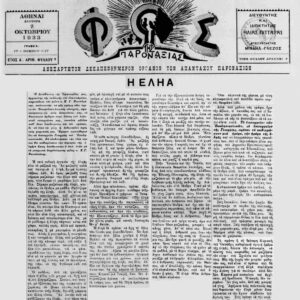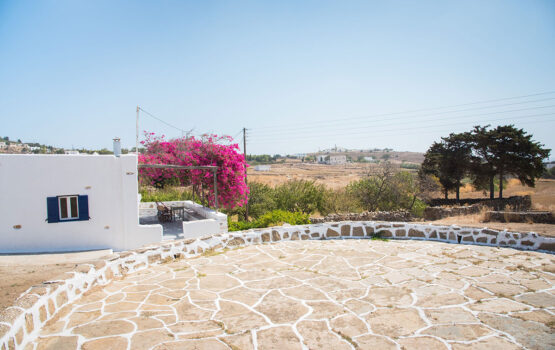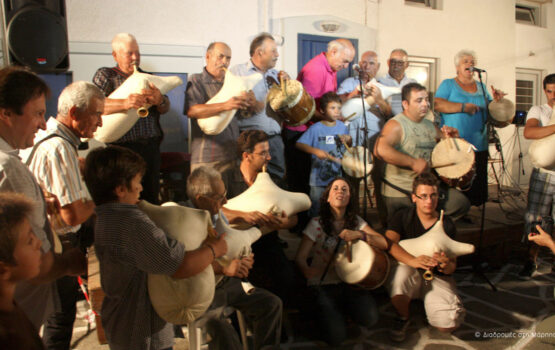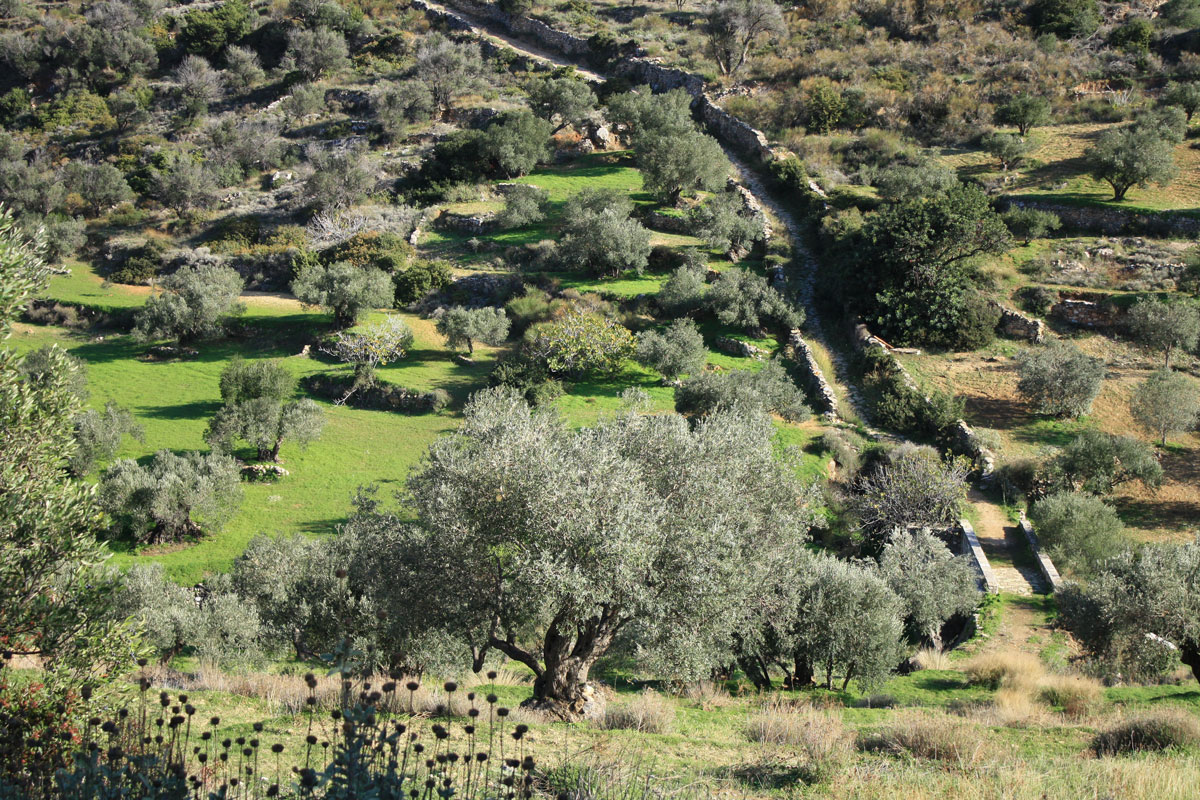
The traditional olive mills
μπερνάς < bερνάς, μπιρνάς < bιρνάς (bernas): the crushed stone of the olive that is left in the olive mill, after the oil has been extracted.
(Aliprantis, 2001)
Oil and olives are products traditionally associated with agricultural production throughout Greece. “How many olive roots (do you have)?” was the question that in the past defined how rich someone was. “The first foundations of a house are wine, bread and oil”, according to a popular proverb, emphasising the importance of these materials for life and prosperity (Bitsakakis, 2020). But how do we get oil from olives? This is where the olive mill comes into play.
After the olive harvest, it is time for the olive mill. The producers carry the olives in bags and tins to get the oil. Production takes place in three phases: Crushing, Compression and Separation. These phases of the process have been followed from antiquity to date (Hadjisavvas, 2004).
Phase one: Crushing
Olives were placed on a hard surface, the kofinia, and a marble cylindrical or semi-cylindrical mill was rolled over them. The mill was called “tsakistiri” (crusher) and it was turned either by workers or by yoked animals (Kolliaros, 2003). The crushing produced a paste that was taken to the press.
Phase two: Compression
The olive paste or “hamouri” was placed on haircloth towels and was led to a press (Kolliaros, 2003). Initially, pressure was exercised by the stamping feet of workers, who by the 6th century had been replaced by machines (Hadjisavvas, 1996). In short, the haircloth towels (“sarganes” or “tsolia” or “boxades”) were pressed by a winch (“stiraki”) that operated using a lever that was turned by workers. Then, they were pressed by the “botzergatis”, a wooden rod that pressed the “sarganes” until they were dry (Kolliaros, 2003). The liquid produced was collected in a basin.
Phase Three: Separation
From the press, oil mixed with “amourgi” or “morgaria” (water and vegetable liquids) came out and entered a tank (basin or casket) (Kolliaros, 2003). The basin had an opening on its lower part near the base. Water, which is heavier, flowed there first while the oil was led to another smaller basin (Margelis, 2009). This process could be followed many times until all oil was extracted from the olives. In the end, everything was rinsed with hot water to remove any last drops of oil.
Then, the oil was stored and the oil mill owner received his payment, usually in the form of oil. The stones (what was left of the above process) were either turned into fuel, or soap, or mixed with bran and fed to the pigs.
The olive groves of Paros
Mrs Anna Trivyza details the process to Kyriaki Ragousi-Kontogiorgou:
The master of each house had his own “liogiri” (olive grove) and harvested his olives to get the oil of the year. The olives were very few, just enough for the household. The olive groves were high on the mountain with tall olive trees; under them, they hand-picked the olives one by one. Nowadays, with the agronomists and all this progress, the olive trees moved lower down to the plains and meadows. Indeed, they came lower down to facilitate the harvest and to increase the oil quantity for each producer. In November, the olives ripened in the olive groves and the master of each householder harvested them and took them to the olive mill, on donkeys. Each village of Paros had two or three olive mills that crushed the olives under two heavy round marble stones, that were turned with difficulty by workers or animals. Once the olives were pulped, they were put in special haircloth fabrics, called “sfyrides” and then in a special machine called “ergatis” and squeezed to extract the oil, which was collected in large basins. From there, with the “kochylas” (shell) they filled the tin containers and with them the bags (“touloumia”) to carry the oil to the “magatze” (warehouse) and to empty it into the jars… It was great toil, my child, but whoever had secured the oil and bread of the year could sleep without a care in the world. (Ragousi-Kontogiorgou, 2004, p.356)
Today there are around 11,000,000 sq.m. of olive groves and 1,300 growers on the island. The most common varieties are Throumbolia and Koroneiki. For table olives, they prefer to pick the fruit from the old trees that have remained from the Venetian period, the Hamadelies, the Dafnelies (for broken or whole) and the Askoudelies (throuba). They also cultivate the Amfissa and Manaki varieties. Although there are three olive mills and Paros ranks second in production in the Cyclades, the oil produced is mainly consumed at home and distributed in the local market. (Dareioti, N., Tsichlaki, Th. and Androulidakis, A.N., 2016, p.186)
The olive mills of Marpissa
In Marpissa there were three olive mills: that of Angelos Patelis, next to Agios Panteleimonas church, of Giannis Tziotis next to Agios Modestos church and of Georgios Kaparos opposite Agios Charalambos church, run along with their partners.
According to the Ongoing Catalogue of the Listed Archaeological Sites and Monuments of Greece, “the olive mill of G. Kaparos was built in 1860 and operated for a whole century until 1964. It has a simple morphology and a rectangular floor plan. It consists of a single space, in the interior of which a typical arch structure is formed. The construction of the roof is also interesting, as it follows the traditional technique of the island, i.e. with wooden beams (“fides”) that are covered with reeds and then with layers of seaweed and soil. All the internal equipment (machinery and movable items) of the olive mill is quite remarkable, as it evident of the organisation of the local rural economy and a reference point for the social life of the inhabitants of the settlement”.
Many locals had their olive groves in the surrounding mountainous areas of the village. They loaded their donkeys with the harvest and went to the olive mills to get the oil.
The millstone and the wheels were made of marble and rested on four crossing pieces of wood. The basin where the oil dripped was also made of marble; from there they collected the oil using large shells (“bouroudes”).
Nikitas Aliprantis remembers that up to five people used to work in the olive mill: “One would organise the operation and used a spatula to remove the olives that stuck onto the slab. The other four were there to turn the marble wheel mechanism by hand”.
The locals in Marpissa remember that with the first oil they got, they made pancakes in the olive press, for good luck! They left them on the window sills for their fellow villagers, for good luck and a good harvest. Over the years, it became a custom to make pancakes with the first oil on the feast day of Saint Andrew, “to prevent the pans from getting holes!”
Sources
Archives of the Association “Routes in Marpissa”.
Aliprantis, N. Chr. (2001) Λεξικό των ιδιωμάτων και των εγγράφων της Πάρου. Με τρεις μελέτες για τα ιδιώματα της Πάρου(Dictionary of idioms and documents of Paros. With three studies on the idioms of Paros). Athens: Association of Lefka People in Athens for Progress and MEEAS “Yria” of Lefkes – Paros.
Darioti, N., Tsichlaki, T. and Androulidakis, A.N. (2016) Του Άνεμου και της Αρμύρας(Of wind and salt). Syros: Cyclades Development and Promotion Company.
Kolliaros, G. (2003) Μιαν βολάν τσ’ έναν τσαιρόν ήτον…(Once upon a time there was…) Athens: Aegeus.
Margelis, S. (2009) Άνθια Αηπετρίτικα(Flowers from Agios Petros). Athens: Margelis.
Ragousi – Kontogiorgou, K. (2004) Πάρος και Αντίπαρος: το εικονοστάσι της ψυχής μου (Paros and Antiparos: the icon stand of my soul). Paros: Anthemion.
Hadjisavvas, S. (1996) “The technology of turning olive fruit into olive oil in antiquity in Cyprus”. Olive and Oil, 4th Three-Day Conference. Kalamata: Cultural Technological Institute, ETVA. pp. 59-69.
Hadjisavvas, S. (2004) “Olive Oil Production in the Ancient Greek World. Ancient Greek Technology and Technique from the prehistoric era to the Hellenistic period with emphasis in prehistoric times.” Proceedings of the Conference, Ohlstadt: Weilheim. pp. 325-339.
Bitsakakis, J. (2020) Cretan Magazine. Available at: www.cretanmagazine.gr [01/12/2020].
Ongoing Catalogue of the Listed Archaeological Sites and Monuments of Greece. (2008) Available at: listedmonuments.culture.gr [01/12/2020].
Special thanks to Mr Nikitas Aliprantis for the information and his valuable assistance.

